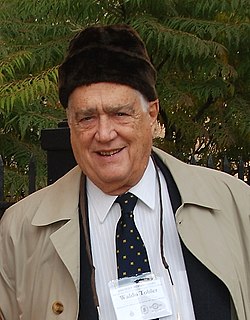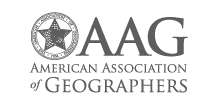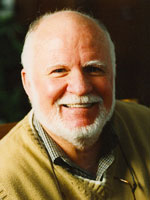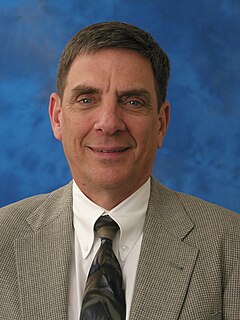Related Research Articles

Waldo Rudolph Tobler was an American-Swiss geographer and cartographer. Tobler's idea that "Everything is related to everything else, but near things are more related than distant things" is referred to as the "first law of geography." He has proposed a second law as well: "The phenomenon external to an area of interest affects what goes on inside". Tobler was an active Professor Emeritus at the University of California, Santa Barbara Department of Geography until his death.
Carl Ortwin Sauer was an American geographer. Sauer was a professor of geography at the University of California at Berkeley from 1923 until becoming professor emeritus in 1957. He has been called "the dean of American historical geography" and he was instrumental in the early development of the geography graduate school at Berkeley. One of his best known works was Agricultural Origins and Dispersals (1952). In 1927, Carl Sauer wrote the article "Recent Developments in Cultural Geography," which considered how cultural landscapes are made up of "the forms superimposed on the physical landscape."

The American Association of Geographers (AAG) is a non-profit scientific and educational society aimed at advancing the understanding, study, and importance of geography and related fields. Its headquarters is located in Washington, D.C. The organization was founded on December 29, 1904, in Philadelphia, as the Association of American Geographers, with the American Society of Professional Geographers later amalgamating into it in December 1948 in Madison, Wisconsin. As of 2020, the association has more than 10,000 members, from nearly 100 countries. AAG members are geographers and related professionals who work in the public, private, and academic sectors.

CLAGS: The Center for LGBTQ Studies was founded in 1991 by professor Martin Duberman as the first university-based research center in the United States dedicated to the study of historical, cultural, and political issues of lesbian, gay, bisexual, and transgender (LGBT) individuals and communities. Housed at the Graduate Center, CUNY, CLAGS sponsors public programs and conferences, offers fellowships to individual scholars, and functions as a conduit of information. It also serves as a national center for the promotion of scholarship that fosters social change.
Latin American studies (LAS) is an academic and research field associated with the study of Latin America. The interdisciplinary study is a subfield of area studies, and can be composed of numerous disciplines such as economics, sociology, history, international relations, political science, geography, gender studies, and literature.

Karl W. Butzer was a German-born American geographer, ecologist, and archaeologist. He received two degrees at McGill University, Montreal: the B.Sc. (hons) in Mathematics in 1954 and later his master's degree in Meteorology and Geography. Afterwards in the 1950s he returned to Germany to the University of Bonn to obtain a doctorate in physical geography. He obtained a master's degree in Meteorology and Geography from McGill University and a doctorate in physical geography from the University of Bonn in Germany.

Billie Lee Turner II is an American geographer and human-environmental scientist, member of the National Academy of Sciences and other honorary institutions. Prominent among the third generation of the Berkeley School of Latin Americanist Geography and cultural ecological research, he has been a leader in bridging this work with the Chicago School of natural hazards and risk research. In August 2008, he took a position as the first Gilbert F. White Chair in Environment and Society at Arizona State University, where he is affiliated with the School of Geographical Sciences and Urban Planning and the School of Sustainability. In November 2015, he was named a Regent’s Professor, the highest faculty honor that can be bestowed by Arizona State University.
Anthony Bebbington is a geographer, International Director for Natural Resources and Climate Change at the Ford Foundation and Higgins Professor of Environment and Society in the Graduate School of Geography, Clark University, USA. He was previously ARC Laureate Professor at the School of Geography, University of Melbourne, Australia (2016-2019).
The International Congress of Americanists (ICA) is an international academic conference for research in multidisciplinary studies of the Americas. Established August 25, 1875 in Nancy, France, the scholars' forum has met regularly since its inception, presently in three year increments, with the exception of during the conflict of World War II. Its meeting location alternates between Europe and the Americas. Congress members come from a variety of disciplines, including anthropology, archaeology, art, education, economy, geography, history, human rights, law, philosophy, linguistics, sociology, and urban studies.

George Babcock Cressey was an American geographer, author, and academic. Born in Tiffin, Ohio, he attended Denison University and then the University of Chicago, where he received a PhD in geology. After receiving his degree, he taught at University of Shanghai and traveled widely in China. Upon his return to the United States in 1929, he completed a pioneering book on the country, China's Geographic Foundations.

William E. Doolittle is an American geographer who is prominent among the fourth generation of the Berkeley School of Latin Americanist Geography. He is currently the Erich W. Zimmermann Regents Professor in Geography at the Department of Geography and the Environment at University of Texas at Austin. He specializes in landscapes and agricultural technology in the American Southwest and Mexico.
Espacio y Desarrollo is an annual Peruvian peer-reviewed scientific journal of geography. It was established in 1989 and is published by the Centro de Investigación en Geografía Aplicada. The current editor-in-chief is Ana Sabogal. Espacio y Desarrollo focuses on environmental geography, linking physical geography and human geography. Contributions often highlight the human-environmental relationship. The regional focus is on Latin America.
Andrew Sluyter is an American social scientist who currently teaches as a professor in the Geography and Anthropology Department of the Louisiana State University in Baton Rouge. His interests are the environmental history and historical, cultural, and political ecology of the colonization of the Americas. He has made various contributions to the theorization of colonialism and landscape, the critique of neo-environmental determinism, to understanding pre-colonial and colonial agriculture and environmental change in Mexico, to revealing African contributions to establishing cattle ranching in the Americas, and to the historical geographies of Hispanics and Latinos in New Orleans. With the publication of Black Ranching Frontiers: African Cattle Herders of the Atlantic World, 1500–1900 and a 2012–13 Digital Innovation Fellowship from the American Council of Learned Societies, he has joined a growing number of scholars from multiple disciplines working from the perspective of Atlantic History and using the tools of the Digital Humanities. His latest book, Hispanic and Latino New Orleans: Immigration and Identity since the Eighteenth Century, co-authored with Case Watkins, James Chaney, and Annie M. Gibson, was awarded the 2015 John Brinckerhoff Jackson Book Prize by the American Association of Geographers.
The Berkeley School of Latin Americanist Geography was founded by the American geographer Carl O. Sauer. Sauer was a professor of geography at the University of California at Berkeley from 1923 until becoming professor emeritus in 1957 and was instrumental in the early development of the geography graduate program at Berkeley and the discipline of geography in the United States. Each generation of this research school has pursued new theoretical and methodological approaches, but their study of the peoples and places of Latin America and the Caribbean has remained the common denominator since the early 20th century. Carl O. Sauer himself did not develop a particular interest in Latin America before 1925, when Oskar Schmieder, a German geographer, disciple of Alfred Hettner, and expert in Latin American regional geography, arrived at Berkeley, coming from Córdoba, Argentina, to work as an associate professor. Obviously, his interest awoke during Schmieder's presence between 1925 and 1930. After Schmieder's departure in 1930, Carl O. Sauer began to offer seminars on the regional geography of Latin America.

Anne Buttimer was an Irish geographer. She was emeritus professor of geography at University College, Dublin.
The Journal of Latin American Geography is a triannual peer-reviewed academic journal published by the University of Texas Press on behalf of the Conference of Latin Americanist Geographers. The journal is abstracted and indexed by Scopus.
Howard F. Cline was an American government official and historian, specialising in Latin America. Cline served as Director of the Hispanic Foundation at the Library of Congress from 1952 until his death in June 1971. He was one of the founders of the Latin American Studies Association. He was also active in the Conference on Latin American History (CLAH), the professional organization of Latin American historians, which he chaired in 1964. He is still highly regarded as a scholar "devoted to and effective in the promotion of Latin American studies in the United States."

Fred Bowerman Kniffen was an American geographer and distinguished professor in the Department of Geography and Anthropology at Louisiana State University for over 64 years. Kniffen had a background in anthropology, geography, and geology when he arrived at Louisiana State University in the late 1920s. While there, he made great strides in the Department of Geography and Anthropology that led to the development of new research areas, additional courses, and well trained graduate students. Kniffen stressed the importance of learning and understanding the history of geography, along with blending physical geography and anthropology with cultural geography. During Kniffen's time at Louisiana State University, he was an advocate for interdisciplinary research. Kniffen became a distinguished professor in the department in 1966, later becoming Boyd professor in 1967.
Oskar Schmieder was a German geographer and expert in the regional geography of Latin America. He spent his early career with Carl O. Sauer at the University of California at Berkeley, where he was an Associate Professor from 1926 to 1930.

Rachel Pain is Professor of Human Geography at Newcastle University since 2017 and was elected a Fellow of the Academy of Social Sciences in 2018.
References
- ↑ [William M. Denevan, "Traditional Versus New Directions: The First Meeting of the Conference of Latin Americanist Geographers, 1970," Journal of Latin American Geography 7 (2008):155-62. doi : 10.1353/lag.0.0013